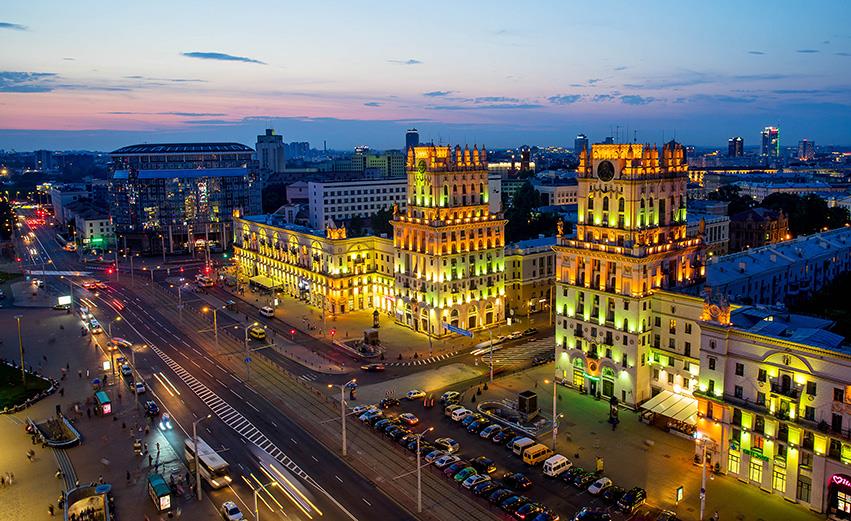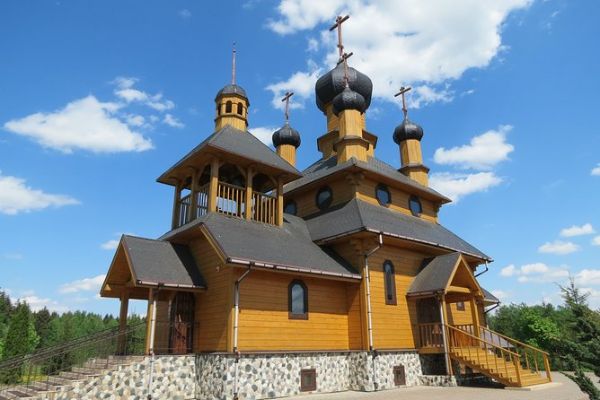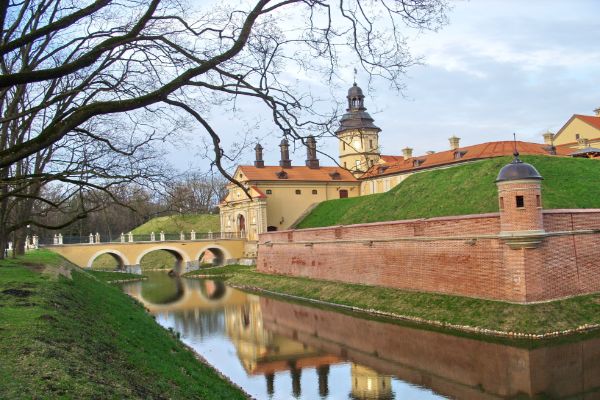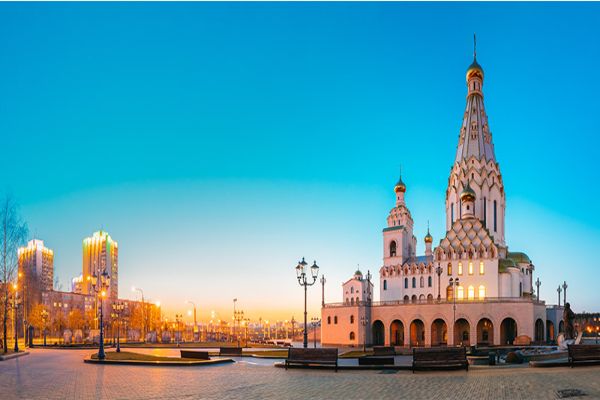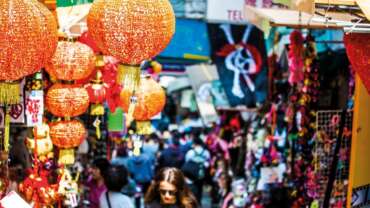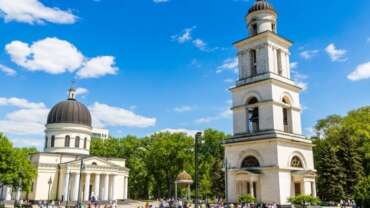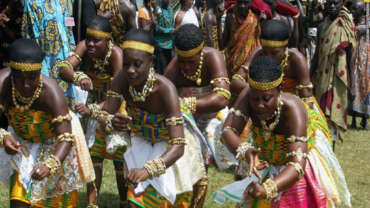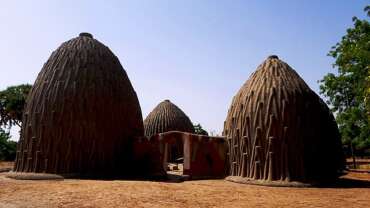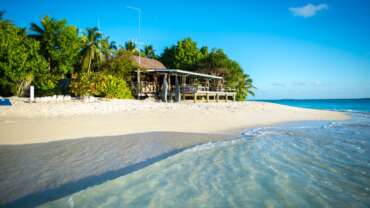MICE Tourism in Belarus - Hospitality without Borders!
Not long ago Minsk wasn’t seen as the place for MICE events. But recently a lot of new hotels and conference halls have been built in the city. Minsk is becoming an attractive place for MICE due to a lot of factors: it has a very attractive geographical position, very attractive prices and very good infrastructure. Local hotels have been renewed for up to 70% now and they are very good technically equipped, have fresh design and original interiors. Besides, the capital of Belarus can offer a high level of European service, a variety of objects on a small territory, great Belarusian roads and highways, clean and wide streets and great care about the security of tourists. All these factors convert Minsk into a new MICE direction.
Every hotel has its own peculiarities. For each event a special place can be picked up, either a posh 5* hotel or a small 3* hotel. There can be any event place found either in a historic building or in a modern high-tech building.
There are unusual places for MICE and team-buiding in Minsk suburbs. For example, Nesvizh Palace can accept 120 people, the yard of the castle is used for concerts and big events and its capacity is designed for 1500 people.
There are also a number of unusual places in Minsk suburbs as well which can be suitable for business meetings. You can ride horses, do sport exercises in the open air, do kayaking and have a folklore performance.
MICE and Event-management:
– Conferences, seminars, exhibitions and international congresses, trainings.
– Industrial round tables, boards of directors, business meetings and conferences.
– Incentive and motivational trips.
– Business trainings and team-building trainings.
– Eventful and festive events.
– Delegation visits at various levels.
History of Belarus
Early history
The Belarusian region has a long history of human settlement. Archaeology has provided evidence of Upper Paleolithic (Old Stone Age) cultures, and Neolithic (New Stone Age) remains are widespread. The area was one of the earliest to be inhabited by Slavs, who settled there between the 6th and the 8th century CE. The early Slavic tribes—the Dregovichi, Radimichi, Krivichi, and Drevlyane—had formed local principalities, such as those of Pinsk, Turaw (Russian: Turov), Polatsk (Russian: Polotsk), Slutsk, and Minsk, by the 8th to 9th century.
These all came under the general suzerainty of Kievan Rus, the first East Slavic state, beginning in the mid-9th century. The regional economy was based on primitive shifting agriculture on burned-over forestland, as well as on honey collecting and fur hunting. Trade developed along the rivers, particularly on the Dnieper, which from about 930 was part of the “water road” from Constantinople (now Istanbul) and the Byzantine Empire, via Kiev (now in Ukraine) and Novgorod (now in Russia), to the Baltic Sea. Trading settlements multiplied, and many of the towns of present-day Belarus had been founded by the end of the 12th century. Two of the earliest-mentioned towns of Slavic foundation, Polatsk and Turaw, first appear in historical documents in the years 862 and 980, respectively. Brest (formerly Brest-Litovsk) is first recorded in 1019 and Minsk in 1067.
Lithuanian and Polish rule
The overthrow of Kiev by the Mongol invasion of 1240 brought about the dissolution of Kievan Rus. Many Belarusian towns were laid waste and became dependencies of the Golden Horde, the western portion of the Mongol Empire. Over the next 150 years the grand duchy of Lithuania expanded, absorbing much of the Belarusian population. Under Lithuanian rule, however, the conquered regions retained a large degree of autonomy. Throughout the 13th and 14th centuries the Lithuanian state grew, encompassing the city of Smolensk (now in Russia) and the lands eastward to the neighbourhood of Moscow and southward to Kiev and the shores of the Black Sea. During this epoch of Lithuanian domination, the Belarusian language and nationality began to take shape.
A personal union between the Lithuanian and Polish ruling houses commenced under the Jagiellon dynasty in 1386, when the Lithuanian grand duke Jogaila married the Polish queen Jadwiga and, taking the name Władysław II Jagiełło, became king of Poland. Roman Catholicism became the official religion of the grand duchy of Lithuania, but the peasantry remained overwhelmingly Orthodox. Between the Polish-Lithuanian realm and the rising power of the Grand Principality of Moscow, there developed an incessant and bitter struggle for land and influence. During the 15th and 16th centuries, Smolensk and Lithuania’s easternmost lands were lost to Russia, although the Belarusian population remained largely under Lithuanian control.
Three sets of laws, known as the Lithuanian Statutes, codified civil and property rights in Lithuanian-controlled lands in the 16th century. In 1557 a far-reaching agrarian-reform plan was instituted, introducing the three-field crop-rotation system of agriculture and changing the obligations of peasants to landowners. The system, initially imposed on crown estates, was rapidly adopted on the properties of the nobility; it remained in operation with little modification until the 20th century. The combined effects of the changes reduced the peasants, who previously had retained at least some freedom to migrate, to full serfdom.
The Union of Lublin (1569) made Poland and Lithuania a single, federated state. Although Lithuania retained the title of grand duchy and its code of laws, its western province Podlasia—which had been heavily settled by Polish colonists—was ceded to Poland, as were the steppe lands and Kiev. Among the Belarusian population a mainly Polish-speaking Roman Catholic aristocracy developed, but the peasantry on the whole remained Orthodox. In 1596 the Union of Brest-Litovsk signaled an attempt to unify the Orthodox and Roman Catholic churches in the Polish-Lithuanian state, combining acknowledgment of papal supremacy with the Orthodox rites and traditions. This new Eastern rite church made some limited headway, particularly among Belarusians and Ukrainians. (However, it later came under pressure from Russian—and, much later, Soviet—authorities, resulting in the conversion of some of its membership to Orthodoxy.) Meanwhile, the rule of the Polish landowners was often heavy and unpopular, and many Belarusians (especially those opposed to joining the Eastern rite church) fled to the steppe lands that were home to the Cossacks.
Large-scale Cossack-led revolts occurred in 1648–54, but the Belarusian lands remained under Poland until the second half of the 18th century. Economic development was slow, especially in the extensive Pripet Marshes. The Belarusian population was almost entirely engaged in agriculture, while trade lay in the hands of Poles and Jews.
Russian rule
By way of the First Partition of Poland in 1772, Catherine II of Russia acquired the eastern portion of present-day Belarus, including the towns of Vitsyebsk (Russian: Vitebsk), Mahilyow (Mogilyov), and Homyel (Gomel). The Second Partition (1793) gave Russia Minsk and the central region, and in 1795 the Third Partition incorporated the remainder into the Russian Empire.
Under Russian rule the area was divided administratively into the governorships (provinces) of Grodno (Belarusian: Hrodna), Minsk, Mogilyov, Vilnia (now Vilnius, Lith.), and Vitebsk. Until the formation of the Belorussian Soviet Socialist Republic in 1919, Belarusian history was largely tied to the course of events in the Russian Empire and revolutionary Russia. Napoleon I, emperor of France, crossed the region in his advance on Moscow in 1812 and again during his retreat. One of the heaviest battles of Napoleon’s Russian campaign took place as French troops retreated across the Byarezina River.
In the 19th century small-scale industries largely based on local supplies began to grow in Belarusian towns. Among them were timber working, glassmaking, and, along the rivers, boatbuilding. Following the emancipation of the serfs in the 1860s, the tempo of industrialization increased somewhat, particularly with the introduction of railways beginning in the 1880s. Nevertheless, the generally poor economic conditions resulted in considerable emigration, especially from rural areas. In the 50 years before the Russian Revolution of 1917, nearly 1.5 million people left the provinces within which present-day Belarus is located. Most of the emigrants went to the United States or Siberia, with more than 600,000 moving to the latter between 1896 and 1915.
The first attempt to establish a Marxist party in Russia took place in Minsk in 1898, when a small congress laid the foundation for the Russian Social-Democratic Workers’ Party. During World War I (1914–18), heavy fighting between German troops and those of the Russian Empire took place in the province with considerable destruction. Following the Russian Revolution, in which a provisional government replaced the collapsed Russian monarchy only to be itself overthrown by Bolshevik revolutionaries, the new Soviet government of Russia signed the Treaty of Brest-Litovsk with Germany and its allies on March 3, 1918. Under the terms of this short-lived treaty, Russia gave up part of present-day Belarus, along with Ukrainian and Baltic lands, to Germany. With Germany’s subsequent defeat by Russia’s Western allies, the terms of Brest-Litovsk were abrogated.
People of Belarus
Ethnic groups
Ethnic Belarusians make up about four-fifths of the country’s population. Russians, many of whom migrated to the Belorussian S.S.R. in the 1960s, ’70s, and ’80s, form the second largest ethnic group, accounting for roughly one-tenth of the population. Most of the remainder are Poles and Ukrainians, with much smaller numbers of Jews, Latvians, Lithuanians, and Tatars. Before World War II (1939–45), Jews constituted the second largest group in the republic (and more than half the urban population); the genocide of European Jewry and postwar emigration nearly eliminated Jews from the republic.
Languages
Both Belarusian and Russian are official languages of Belarus. Belarusian, which is central to the concept of national identity, is an East Slavic language that is related to both Russian and Ukrainian, with dialects that are transitional to both. It is written in a Cyrillic alphabet and has loanwords from both Polish and Russian, which is reflective of the region’s history. An older form of Belarusian was the official language of the grand duchy of Lithuania, of which present-day Belarus was an important component.
Religion
About half of Belarusians consider themselves nonreligious or atheist. Roughly two-fifths of the population adheres to Eastern Orthodoxy, which, while not the official religion, maintains a privileged status in Belarus. Roman Catholics constitute the largest religious minority. Roman Catholicism is particularly influential in the western regions, especially in Hrodna. Tiny fractions of the population follow other forms of Christianity, Judaism, or Islam. The Tatars are the predominant Muslim group.
Art & Culture of Belarus
The arts
Architecture
One of the oldest surviving monuments of architecture in the country is the Cathedral of St. Sophia in Polatsk, dating from the 11th century and built in the Eastern Orthodox style. The church of Boris and Gleb (Barys and Hlyeb) in Hrodna dates from the 12th century. Most of the other early buildings that remain, mostly as ruins, are the princely stone fortresses of the 12th to 16th century. One of the best-known of these is the 13th-century White Tower in Kamyanyets.
The 17th century marked the appearance of the Baroque style, which was largely linked to the eastward movement of Roman Catholicism; it is exemplified by the design of the Jesuit, Bernardine, and Bridgettine churches in Hrodna. Belarusian craftsmen played a role in extending Baroque influence farther eastward into Russia, where it was adapted as the “Moscow Baroque” style. By the 18th century, Classical styles predominated in Belarus, as seen in the Governor’s Palace in Hrodna. The ravages of World War II destroyed a large segment of the country’s architectural heritage, especially in Minsk. Because much of Minsk was reconstructed after the war, most of the architecture of the city centre reflects the grandiose Stalinist style with its Classical borrowings.
Literature
Literary activity in Belarus dates to the 11th century. In the 12th century St. Cyril of Turaw, venerated among Orthodox Slavs as “the second St. Chrysostom,” wrote sermons and hymns. In the 16th century Francisk Skorina of Polatsk translated the Bible into Belarusian and wrote extensive explanatory introductions to each book. His editions, produced in Prague (now in the Czech Republic) in 1517–19 and in Vilnius (Lithuania) in 1522–25, were the first printed books not only in Belarus but in the whole of eastern Europe. In the 17th century the Belarusian poet Simeon Polotsky (Symeon of Polatsk) was the first to bring Baroque literary style to Moscow.
Modern Belarusian literature began in the first half of the 19th century with the work of Yan Chachot and Vincent Dunin-Martsinkyevich, who translated part of the Polish poet Adam Mickiewicz’s epic Master Thaddeus into Belarusian. Literary classics of the early 20th century include works by the poets Maksim Bahdanovich, Ales Harun, Vladimir Zylka, Kazimir Svayak, Yanka Kupala, and Yakub Kolas and the prose writers Zmitrok Byadulya and Maksim Haretski. Many of these writers had been contributors to the influential Belarusian newspaper Nasha Niva (“Our Field”), published in Vilnius during the period 1906–16. Of crucial importance for an understanding of the Belarusian cultural predicament in the face of war and revolution are Kupala’s play The Locals (1922) and Haretski’s short novel Two Souls (1919).
Many outstanding poets and prose writers made their mark in the 1920s, including the poets Vladimir Dubovka and Yazep Pushcha, the novelist Kuzma Chorny, and the satirist and playwright Kandrat Krapiva. Pushcha’s literary polemics with the poet Andrey Aleksandrovich at the end of the 1920s led to tighter political control over Belarusian cultural activities. Literature in the part of Belarus that was under Polish control—until Soviet forces occupied it in 1939—developed somewhat more freely. Two writers of note emerged from that area: Maksim Tank, author of the long poems Narach (1937) and Kalinowski (1938), and Natalla Arseneva, whose greatest poems are to be found in the collections Beneath the Blue Sky (1927), Golden Autumn (1937), and Today (1944).
Most noteworthy of the writers to preserve and develop the Belarusian literary tradition in the 1940s and ’50s are the poets Pimen Panchanka and Arkadi Kulyashov and the prose writers Yanka Bryl, Ivan Shamyakin, and Ivan Melezh. The 1960s marked the tentative beginnings of yet another national revival with the novels of Vasil Bykau and Uladzimir Karatkievich. Among later 20th-century writers, the poets Yawhyeniya Yanishchyts and Ales Razanov and the short-story writer Anatol Sys should be noted. Other well-known writers of the late 20th and early 21st centuries are Svetlana Alexievich, whose Voices from Chernobyl was translated into English in 2005; Volha Ipatava, a prominent poet and novelist; and the poet Slavamir Adamovich, whose poem “Kill the President!” led to his imprisonment in 1996–97. Several prominent Belarusian writers left the country in the late 20th and early 21st centuries because of the political climate. They included Bykau and Ales Adamovich, both well known for their works on the Soviet-German conflict during World War II.
Music
Belarus has long had its own folk music. There was also a considerable tradition of church music from the 16th century on. The development of classical music largely has been a feature of the period since World War II. Among the most notable composers is Kulikovich Shchahlow, who, like some writers, went into exile after the war. Others include Yawhen Hlyebaw, composer of the opera Your Spring (1963) and the ballet Alpine Ballad (1967), and Yawhen Tsikotski, whose works include the operas Mikhas Padhorny (1939–57) and Alesya (1944). There are a conservatory of music in Minsk and a national philharmonic society. Concerts are held regularly at the Nyasvizh (Nesvizh) and Mir castles, which were designated UNESCO World Heritage sites in 2005 and 2000, respectively.
Cultural Life
Cultural milieu
Little survives in Belarus of the earliest period of settlement by east Slavs. A distinctively Belarusian culture began to emerge clearly only in the 16th century. As Belarusian culture developed, however, long periods of foreign control—first by the grand duchy of Lithuania and the kingdom of Poland, then by tsarist Russia, and later by the Soviet Union—introduced a series of outside influences, from the European Baroque and Classical architectural styles to the cultural constraints of Socialist Realism. Yet notwithstanding the considerable efforts made by Russian tsars and Soviet rulers to suppress the Belarusian language and culture, Belarusians succeeded in preserving their distinctiveness as a people.
Daily life and social customs
Independence Day, the national holiday of Belarus, is celebrated on July 3, the date of the Soviet liberation of Minsk from German occupation in 1944. Some Belarusians, particularly opposition groups, still recognize the holiday’s former date, July 27—the date on which state sovereignty was declared in 1990. The opposition also celebrates March 25, the date of the declaration of independence by the short-lived Belarusian National Republic in 1918. Most Soviet holidays are still commemorated, especially Victory Day (May 9), as are religious holidays, including both the Orthodox and Roman Catholic Easters.
A presidential fund for culture and the arts provides for a number of annual and biannual festivals. Among the most notable festivals in Belarus are the Slavic Bazaar in Vitsyebsk, an international festival of the arts; the Spring International Music Festival in Minsk; and the Arts for Children and Youth festival.
After independence the country’s total fertility rate fell below two children per childbearing woman; most families are thus small in size. Many families spend summers at dachas, or country cottages, growing local produce. The practice of mushroom picking remains very popular.
Much Belarusian cuisine incorporates locally grown crops. Potatoes are a nearly ubiquitous ingredient, featured in such popular dishes as potato dumplings, potato pancakes, and baked potato pie. Other common dishes, often served with rye bread, include borsch (beet soup), pork stew, stuffed chicken, beef sausage, and meat- or cabbage-filled pastries. Well-known dairy products are a fresh cheese (tvorog) and a fermented cheese (siyr). Kvass is a traditional drink made from fermented bread, and kompot is a berry juice. Vodka is typically the alcoholic drink of choice, although beer has become popular, especially among younger drinkers.
Popular natural tourist destinations - Forests, rivers, lakes and swamps of Belarus
BELOVEZHSKAYA PUSHCHA – Belovezhskaya Pushcha is the largest primeval forest in Europe. Here you can find bisons and lynxes that are rare in the world, and more than half of the plants that are growing in the country. If the cold will blow, you know, Santa Claus’ residence is nearby.
AUGUSTOW CHANNEL (A UNIQUE WATER SYSTEM) – Part of this unique channel is located in Belarus and a part is located in Poland. Crossing the interstate border, kayaking or by boat is considered quite an adventure by the locals. In addition, since October 2016 you do not need a visa for doing this. The channel connects seven lakes and is ideal for those who prefer recreationional activities.
NALIBOKSKAYA PUSHCHA – Nalibokskaya Puscha is a real mystical place. According to tradition, a church once located here sank and a lake with a surprisingly smooth coastline appeared in its place. They say that in the quiet of the night over the water, you can hear the sound of bells. The Lavrishevsky monastery that was built side by side, on the left bank of the Neman, suddenly appeared on the right bank of the river. Did you know there is also a famous Naliboksky alcoholic beverage?
BEREZINSKY BIOSPHERE RESERVE (MOOR) – Moors occupy about 60% of Berezinsky Reserve. Thousands of tourists come here every year to see how the lady’s slipper orchids blossom and the iridescent colors of marshy meadows. Locals say that in the Berezinsky Reserve frogs croak in synchronous collaboration. Worth checking out!
YELNYA (MOOR) – Yelnya is one of the largest moors in Europe. Here you will find tons of cranberries, lingonberries and blueberries. Its second name is “bird house”. About 7,000 cranes and hundreds of species of migratory birds make a stop here. A little secret of hospitable Yelnya is that if you forget to bring your water, do not worry. Next to the moor, you will find more than 100 crystal clear lakes, which you can drink from.
BRASLAV LAKES – There are 74 picturesque lakes, 30 species of fish, more than 10 kinds of hunting and 2 environmental tracks – everyone will find something that they enjoy. Climb Mayak (Lighthouse) hill and try not to admire the opened view. Be warned: it will be difficult.
NAROCH – Naroch is a blue pearl of Belarus; it is the largest and cleanest lake. It’s a sandy beach with white swans that you have a chance to see all from the view of a helicopter. You can visit the park of rare plants and learn how to dive.
BLUE LAKES – The natural system “Blue Lakes” has the status of a key botanical territory of Belarus. In addition to picnics and swimming, we invite you to go to the Forest Museum to learn about the main natural wealth of Belarus. By the way, it is located in the forest. After all the heard legends of Blue Lakes, be sure to wash in the refreshing Boltiksky spring.



